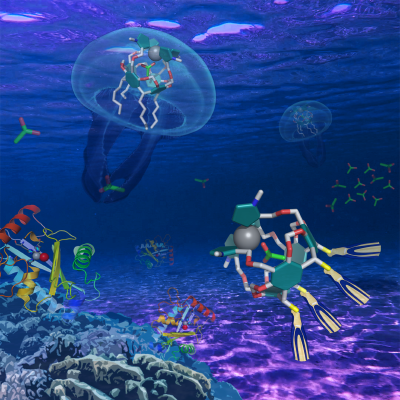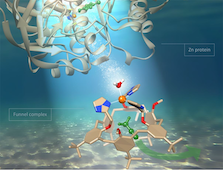In the same section
-
Share this page
Molecular recognition: from organic solvents to water
We are interested in understanding the underlying factors that govern molecular recognition processes in solution, with a particular interest in the development of systems that function in water. Here is below a short summary of the themes that we are currently focusing on in the EMNS lab.
#1 Elaboration of micellar systems for analyte recognition in water
A notable challenge is the field of supramolecular chemistry is the development of receptors that work in an aqueous medium, where most biological and environmental processes occur. Water is indeed a competitive solvent. It screens polar interactions and as water molecules are excellent H-bond donors/acceptors they can efficiently solvate the different binding partners and actively interfere in the recognition processes. Most receptors developed to date are furthermore poorly soluble in water.

Extensive physicochemical characterization of the nanosystems are undertaken (UV-Vis absorption and emission spectroscopies, microcalorimetry, advanced NMR methodologies) in order to elucidate the underlying factors that govern the molecular recognition processes.
Head: Prof. Kristin Bartik
Co-workers/researchers:
Collaborations: Prof. Antonella Dalla Cort (La Sapienza - Roma), Prof. Ivan Jabin (ULB, Laboratory of Organic Chemistry), Prof. Olivia Reinaud (Paris Descartes)
Funding: COST, FNRS-FRIA PhD Fellowships
Publications:
Binding of Bioactive Ammonium Ions in Water with a Cavity-Based Selectivity: Water Solubilization versus Micellar Incorporation
Carpentier, R., Testa, C., Pappalardo, A., Jabin, I., & Bartik, K., JOC 90(1), 682–690 (2024).
Development of a water-soluble ouroboros-like calix[6]arene-trisimidazole-based ligand for enhanced binding of zinc
Carpentier, R., Lavendomme, R., Colasson, B., Bartik, K., & Jabin, I., Dalton transactions 54, 1052-1062 (2024).
Specific Binding of Primary Ammoniums in Aqueous Media by Homooxacalixarenes Incorporated into Micelles
Carpentier R., Lambert S., Brunetti E., Jabin I. and Bartik K., J. Org. Chem. 87 (19), 12749–12758 (2022).
Submerging a Biomimetic Metallo‐Receptor in Water for Molecular Recognition: Micellar Incorporation or Water Solubilization? A Case Study
Collin S., Parrot A., Marcelis L., Brunetti E., Jabin I., Bruylants G., Bartik K. and Reinaud O., Chem. Eur. J. 24, 17964-17974 (2018). ! Cover Picture !
Primary Amine Recognition in Water by a Calix[6]aza-cryptand Incorporated in Dodecylphosphocholine Micelles
Brunetti E., Inthasot A., Keymeulen F., Reinaud O., Jabin I. and Bartik K., Organic & Biomolecular Chemistry 13, 2931-2938 (2015).
Fluoride Binding in Water with the Use of Micellar Nanodevices Based on Salophen Complexes
Keymeulen F., De Bernardin P., Giannicchi I., Galantini L., Bartik K. and Dalla Cort A., Organic & Biomolecular Chemistry 13, 2437-2443 (2015).
Paramagnetic Relaxation Enhancement Experiments: A Valuable Tool for the Characterization of Micellar Nanodevices
Keymeulen F., De Bernardin P., Dalla Cort A. and Bartik K., J. Phys. Chem. B 117(39), 11654-11659 (2013).
Fluoride Binding in Water: A New Environment for a Known Receptor
Cametti M., Dalla Cort A. & Bartik K., Chem.Phys.Chem. 9, 2168-2171 (2008).
#2 Physicochemical characterization of host-guest complexes

We undertake extensive phyicochemical characterization of these type of host-guest complexes (UV-Vis absorption and emission spectroscopies, microcalorimetry, advanced NMR methodologies) in order to elucidate the underlying factors that govern the molecular recognition processes
Head: Prof. Kristin Bartik
Co-workers/researchers:
Collaborations: Prof. Ivan Jabin (ULB, Laboratory of Organic Chemistry), Prof. Olivia Reinaud (Paris Descartes), Prof. Antonella Dalla Cort (La Sapienza)
Funding: FNRS-FRIA PhD Fellowships
Publications:
Development of a Cone Homooxacalix[3]arene-Based Fluorescent Chemosensor for the Selective Detection of Biogenic Ammonium Ions in Protic Solvents
Lambert, S., Carpentier, R., Lepeintre, M., Testa, C., Pappalardo, A., Bartik, K., & Jabin, I., JOC 89(15), 10903–10911(2024).
Supramolecular protection with a recyclable molecular container: an efficient strategy for the one-pot selective functionalization of polyfunctional substrates
Lambert S., Bartik K. & Jabin I., Org. Chem. Front. (2023)
A Water Molecule Triggers Guest Exchange at a Mono-Zinc Centre Confined in a Biomimetic Calixarene Pocket: a Model for Understanding Ligand Stability in Zn Proteins
Brunetti E., Marcelis L., Zhurkin F.E., Lhumer M., Jabin I., Reinaud O. & Bartik K., Chem. Eur. J. 27(55), 13730-13738 (2021).
Specific Binding of Primary Ammonium Ions and Lysine-Containing Peptides in Protic Solvents by Hexahomotrioxacalix[3]arenes
Lambert S., Bartik K. & Jabin I., The Journal of Organic Chemistry 85, 10062-10071 (2020).
A Selective Calix[6]arenes-based Fluorescent Chemosensor for Phosphatidylcholine Type Lipids
Brunetti E., Moerkerke S., Wouters J., Bartik K. and Jabin I., Organic and Biomolecular Chemistry 14, 10201-10207 (2016).
Colorimetric and fluorescence “turn-on” recognition of fluoride by a maleonitrile-based uranyl salen-complex
Bartocci S., Sabaté F.,Bosque R., Keymeulen F., Bartik K., Rodríguez L., Dalla Cort A., Dyes and Pigments 135, 94-101 (2016).
Fluorescent Chemosensors for Anions and Contact Ion Pairs with a Cavity-Based Selectivity
Brunetti E., Picron J.-F., Flidrova K., Bruylants G., Bartik K. and Jabin I., Journal of Organic Chemistry 79(13), 6179-6188 (2014).
#3 Development of micellar nanocatalysts for biomass conversion in water
 There is currently great interest for the development of environmental-friendly synthetic processes and, in this context, the replacement of commonly-used volatile organic solvents by water is of prime interest. Water is a solvent with little environmental impact, but its use has been limited because organic substrates and catalysts are often poorly soluble in water. Micellar systems represent one of the simplest methods to transfer organic catalysis into an aqueous environment. In collaboration with the University of Padova, we are investigating the potential of vanadium-based catalysts in micellar media for the depolymerisation of lignin units. The conversion of model substrates is monitored by NMR and HPLC in order to identify the key parameters controlling the conversion yield in these heterogenous systems. This project is undertaken in the framework of the COST FP1306 Action «Valorisation of lignocellulosic biomass».
There is currently great interest for the development of environmental-friendly synthetic processes and, in this context, the replacement of commonly-used volatile organic solvents by water is of prime interest. Water is a solvent with little environmental impact, but its use has been limited because organic substrates and catalysts are often poorly soluble in water. Micellar systems represent one of the simplest methods to transfer organic catalysis into an aqueous environment. In collaboration with the University of Padova, we are investigating the potential of vanadium-based catalysts in micellar media for the depolymerisation of lignin units. The conversion of model substrates is monitored by NMR and HPLC in order to identify the key parameters controlling the conversion yield in these heterogenous systems. This project is undertaken in the framework of the COST FP1306 Action «Valorisation of lignocellulosic biomass».
Head: Prof. Kristin Bartik
Collaborations: Prof. Giulia Licini (University of Padova)
Funding: COST, Fondazione Cassa di Risparmio di Padova e Rovigo PhD fellowship
Publications:
Vanadium Catalyst in Micelles: Towards a Greener Aerobic Oxidative Cleavage of Vicinal Diols in Water
Carpentier R., Denis W., Sanz Azcona F., Carraro D., Grauwels G., Orlandi M., Zonta C., Licini G. & Bartik K., ACS Sustainable Chemistry & Engineering 11(23), 8633-8641(2023).
Efficient Vanadium‐Catalyzed Aerobic C‐C Bond Oxidative Cleavage of Vicinal Diols
Amadio E., Gonzalez-Fabra J., Carraro D., Denis W., Gyoka B., Zonta C., Bartik K., Cavani F., Solmi S., Bo C. and Licini G., Adv. Synth. Catal. 360(17), 3286-3296 (2018).
